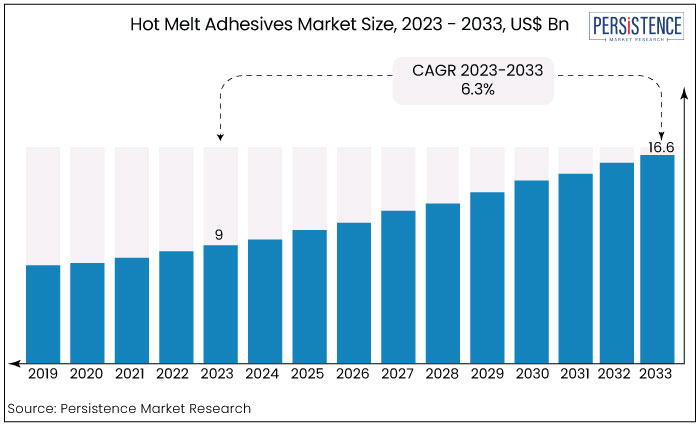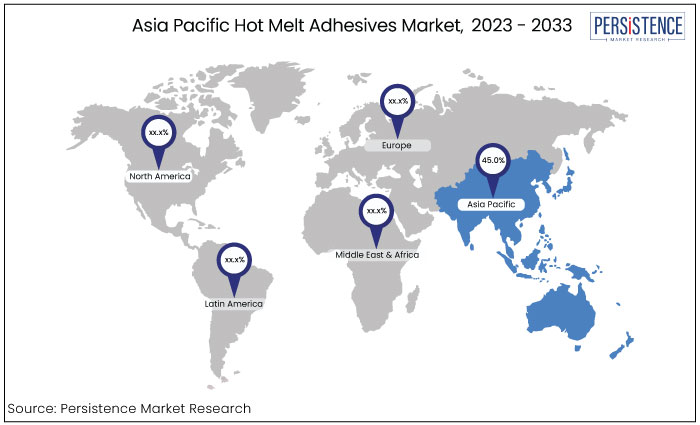ID: PMRREP3378| 170 Pages | 25 Jun 2024 | Format: PDF, Excel, PPT* | Chemicals and Materials

The hot melt adhesives market is estimated to reach a valuation of US$16.6 billion by the year 2033, at a CAGR of 6.3% during the forecast period 2023 to 2033.

Key Highlights of the Market
|
Attributes |
Key Insights |
|
Market Value (2023) |
US$9 Bn |
|
Market Size (2033) |
US$16.6 Bn |
|
Forecast Growth Rate (CAGR 2023 to 2033) |
6.3% |
|
Historical Growth Rate (CAGR 2019 to 2022) |
2.5% |
Hot melt adhesives, commonly referred to as hot glue or thermoplastic adhesives, are a type of adhesives that are applied in a liquid condition and harden upon cooling to strengthen joints or assemblies.
Hot melt adhesives consist of thermoplastic polymers, including polyamides, polyolefins, polyesters, and ethylene-vinyl acetate (EVA), which are melted and then spread onto a surface in a liquid or semi-liquid state.
Hot melt adhesives are extensively utilized in multiple industries, including packaging, woodworking, construction, and automotive manufacture, to securely attach a diverse array of materials, such as plastics, wood, metal, and textiles.
These types of adhesives are preferred over alternative adhesives, such as solvent-based or water-based adhesives, due to their rapid curing time, exceptional adhesive strength, and user-friendly application.
Increased use of hot melt adhesives in packaging industry is a growth-aiding trend for the market. The increased use of hot melt adhesives in the packaging sector creates a substantial demand.
Hot melt adhesives are extensively used by the packaging industry for adhering packaging materials such as paperboard, corrugated cardboard, plastic films, and foils in several applications, including box and carton sealing, tray forming, labelling, and lamination.
Further, the demand for hot melt adhesives in the packaging industry is rising due to the growing consumption of food and the wide range of applications it can be used for.
The hot melt adhesives market size has been growing substantially during the last decade and is predicted to maintain the said growth rate during the forecast period.
Hot melt adhesives are widely used in a variety of industries, such as construction, packaging, disposable sanitary items, bookbinding and paper binding, textile, footwear, and electronics.
The global hot melt adhesives market share has seen a significant growth during the historical period 2019 to 2022, exhibiting a compound annual growth rate (CAGR) of 2.5%.
In the manufacturing of disposable non-woven hygiene products, such as baby diapers (nappies), adult incontinence products, feminine care items, medical dressings, surgical drapes, and hospital bed pads, hot melt adhesives are employed.
The market has benefited from the healthcare sector's rising need for hot melt adhesives for non-woven hygiene products. The healthcare industry is an ever-growing industry and after the COVID-19 pandemic, people are more aware of health & hygiene and more concerned about personal hygiene.
The need for hot melt adhesives for personal hygiene products is increasing as a result of the aging population and developments in medical procedures.
The market for non-woven hygiene products is being driven by rises in per capita income and living standards in economies such as India, China, Taiwan, Indonesia, and Malaysia, which eventually aids the growth of the hot melt adhesives market.
Increased Demand from Packaging Industry
Hot melt adhesives are extensively used in the packaging industry for various applications, including case sealing, corrugated waxed board, tray forming, carton sealing of standard bleached sulfate (SBS), heat sealing, and container labelling.
Such adhesives are often utilized in conversion and packaging applications as they surpass water-based adhesives in terms of both the time it takes to set and the excellent water resistance properties, which is one of the notable advantages of hot melt adhesives.
The utilization of these adhesives leads to a substantial reduction in the packaging system or area. Emerging economies like India, and China are experiencing an increasing demand for online shopping.
These countries possess a substantial quantity of e-commerce enterprises. Moreover, the increasing demand for labels, and plastic bags in packaging sector is further fueling the demand for the hot melt adhesives.
Non-woven Hygiene Healthcare Industry
Hot melt adhesives are increasingly utilized in the manufacturing of single-use, non-woven hygiene items, including infant diapers, feminine care products, adult incontinence products, medical dressings, hospital bed pads, and surgical drapes.
The said market segment is expected to be driven forward by the growing demand for hot melt adhesives in the healthcare industry, primarily for non-woven hygiene products.
Furthermore, the market share is expected to grow significantly owing to its advantages over other options, including excellent solvents and acids and being a cost-effective option.
Considering the increasing elderly population and the recent developments in medical procedures, the hot melt adhesives market size is predicted to grow substantially over the forecast period.
Stringent Regulations by Governments, and High Costs
Certain restraining factors, such as stringent rules and regulations set by regulatory organizations all over the world, are some of the key factors impeding the growth of the hot melt adhesives market.
Some of the major chemical manufacturers globally have been subjected to strict environmental laws to mitigate the negative impacts of the compounds on the environment.
The high costs of the hot melt adhesives are primarily attributed to the high fluctuations in the raw material prices and the disruptive supply chain, which is directly impacting the market revenue over the forecast period.
Increased demand for reactive hot melt adhesives
In comparison to conventional solvent-based formulations, reactive hot melt adhesives have a very low or even non-existent volatile organic compound (VOC) content.
Compared to the conventional alternatives, the reactive hot melt adhesives are more environment-friendly as they do not contain any solvent and have achieved compliance with standards regarding VOC content.
Currently, manufacturers are focusing on the utilization of environmentally friendly products, which is leading to an increase in the demand for these adhesives.
Additionally, these adhesives can eliminate the need for solvents and leverage additional benefits, such as reduced costs for labour and energy used.
The use of dryers is not necessary for reactive hot melt adhesives, which results in lower energy expenditures.
They have great adhesion to a wide variety of substrates, including wood, textiles, plywood, particleboards, foams, metals, and plastics, in addition to their mechanical features, which include flexibility, high strength, and excellent adherence.
Nearly 40% Market Value Share Contributed by Ethylene Vinyl Acetate
|
Market Segment by Product |
Market Value Share |
|
Ethylene Vinyl Acetate |
40% |
Based on the product type, the hot melt adhesives market is further segmented into ethylene vinyl acetate and rubber, where the ethylene vinyl acetate (EVA) segment dominates the market share.
EVA is a copolymer adhesive that is utilized in a variety of industries, including automotive, paper, assembly, and packaging.
Major characteristics that are driving the expansion of the segment include excellent adhesion, great mechanical strength, paraffin solubility, and outstanding flexibility.
The Rubber segment is further expected to witness staggering growth during the forecast period from 2023 to 2033. Most of the product's applications are in the adherence of pressure-sensitive goods, including labels, tapes, and graphics.
The product's ability to provide rapid bonding speeds up the manufacturing process, which in turn reduces the amount of time and money spent on labour, which in turn drives the expansion of the market.
Packaging Applications Account for 35% of Total Demand
|
Market Segment by Application |
Market Value Share |
|
Packaging |
35% |
Based on application, the hot melt adhesives market is further bifurcated into packaging and automotive, where the packaging segment marginally dominates the automotive segment to earn a substantial market share of about 35% of the total market share.
The primary reason for hot melt adhesives being used in the packaging industry is their ability to withstand extreme conditions and challenges, and thus are utilized in the packaging industry to close the flaps of corrugated boxes and paperboard cartons.
To insulate and protect the components of electronic devices, several producers of electronic devices utilize hot melt adhesives to adhere parts and wires to the device.
Major automobile manufacturers manufacturing trucks and heavy vehicles are found to make substantial use of hot melt adhesives for adhering carpets, headliners, radiators and batteries to the vehicles.
Due to the extended use of hot melt adhesives in the automobile sector, it is said to earn a substantial market share and have a significant growth rate over the forecast period 2023 to 2033.
Surging Popularity of Non-wovens, and e-Commerce Boom Benefit Asia Pacific’s Leadership
Asia Pacific dominates the global market share for the hot melt adhesives market and is said to maintain the highest market share, surpassing 45.0%.
The primary factor driving market growth in the Asia Pacific region is the rapid increase in demand for non-woven products, in conjunction with the substantial expansion of e-commerce services.
The product demand is being driven by the extensive application of hot melt adhesives, which is resulting in a surge in opportunities in the competitive business sector.
During the forecast period, it is anticipated that North America will experience a compound annual growth rate (CAGR) of 4.3% in terms of revenue.
The presence of some of the largest packaging manufacturers, such as International Paper, Ball Corporation, and Owens-Illinois, is expected to be the primary factor driving market growth in the region.
Europe Emerges as a key Regional Market
Europe is anticipated to experience consistent growth throughout the forecast period. The market development in the region is said to be positively impacted by the growing automotive sector.
The increased demand for online product delivery services, and the pacing construction activities in developed countries of Western Europe, including Italy, the UK, Germany, France, and Spain are also favoring market growth here.

March 2022 –
H.B. Fuller announced that it will introduce a metallocene range of adhesive solutions for bookbinding and other such applications, which will make their company enter another key sub-segment of the market.
February 2022 –
Arkema signed an acquisition deal with Ashland Performance adhesives to acquire its high-end products portfolio and expand its business on a global note as a key player in the adhesive industry.
January 2022 –
H.B. Fuller signed an acquisition deal with Apollo, a UK-based liquid adhesive manufacturer, which also produces coatings and primers, to expand its operations where Apollo will operate within H.B. Fuller’s existing business units.
The major competitors in the hot melt adhesives market are primarily evaluated based on their product or service offerings, their financial statements, developments and the approaches implemented, the company's position in the global market scenario and its geographical reach.
The key competitors studied have also been accessed through the SWOT analysis to understand their strengths, weaknesses, opportunities and threats.
By Product
By Application
By Region
The hot melt adhesives market is projected to have a CAGR of 6.3%.
Ethylene vinyl acetate dominates the global market share in product segmentation.
Asia Pacific region has the major market share of about 45%.
The global hot melt adhesives market is estimated to be valued at US$16.6 bn in 2033.
High demand from the packaging industry is the major driving factor for the market.
|
Attributes |
Details |
|
Forecast Period |
2024 - 2033 |
|
Historical Data Available for |
2019 - 2023 |
|
Market Analysis |
US$ Billion for Value |
|
Key Countries Covered |
|
|
Key Companies Profiled |
|
|
Pricing |
Available upon request |
Delivery Timelines
For more information on this report and its delivery timelines please get in touch with our sales team.
About Author